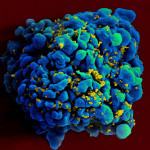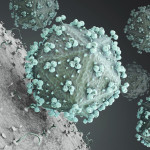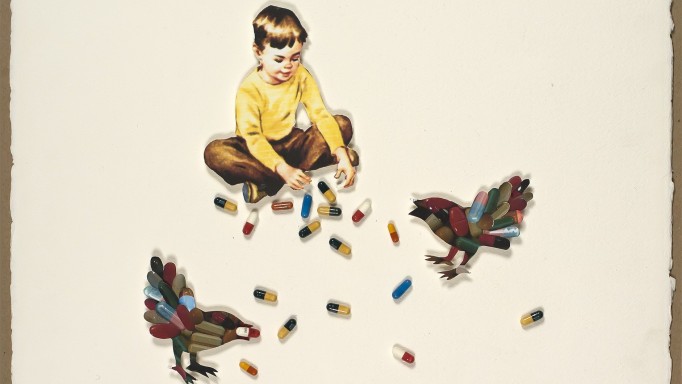Lymphoma is cancer of the lymph system, a network of lymph nodes, organs (spleen, thymus, tonsils, etc.), and vessels that help make up the immune system. Different types of lymphoma exist, and they can be divided into two groups: Hodgkin’s lymphoma and non-Hodgkin lymphoma (NHL). The major difference between the two is the type of cells involved.
Generally speaking, Hodgkin’s lymphoma is easier to treat than NHL but NHL is more common. Lymphoma is easiest to treat in its early stages, when the cancer hasn’t spread beyond the lymph system. Lymphoma that spreads to bone marrow or develops in the brain can be more difficult to treat.
People living with HIV are at a slightly higher risk for developing NHL than HIV-negative people. NHL can also worsen faster in people with HIV, and can be more difficult to treat. It is not clear if people with HIV are at a higher risk for developing Hodgkin’s lymphoma. However, it does occur and, because of underlying immune suppression, it can progress quicker and may be more difficult to treat.
Several studies have found that fewer people with HIV are being diagnosed with lymphoma today than they were in the years before the start of potent HIV treatment. The risk of developing one of the more serious types of lymphoma—such as lymphoma of the brain—has dramatically decreased. However, other types of NHL—Burkitt lymphoma, etc.—have not decreased.
Lymphomas are more likely to occur when CD4 counts are below 200, while primary CNS lymphoma is more likely below 100 CD4s. However, some cases of lymphoma have occurred at higher CD4 counts.
While the cause of lymphoma is still not known, some researchers believe that environmental toxins—such as pesticides—may cause this form of cancer. The Epstein-Barr virus (EBV) has also been found to play a role in how lymphoma develops, particularly in people with HIV.
What are the symptoms of lymphoma?
Lymphomas generally cause tumors (“oma” can mean “tumor”) to develop somewhere within the lymph system. Sometimes these tumors can be felt or seen under the skin. They can also occur deep within the body, perhaps within an organ (gut, bone marrow, brain, liver).
A number of symptoms are possible: swollen lymph nodes, tiredness, enlarged spleen, liver obstruction, rectal pain, irregular heartbeat, digestive problems, and internal bleeding. Very often, lymphoma causes fever, unexplained weight loss, itching and night sweats.
Lymphoma of the brain—called primary central nervous system (CNS) lymphoma—usually causes other symptoms. These include problems focusing, paralysis affecting one side of the body, loss of ability to speak or understand language, confusion, sudden memory loss, and mania.
How is lymphoma diagnosed?
First, health providers will review your medical and family histories, including to check if any lymph organs are swollen. If you’ve had earlier conditions related to EBV, you’re at an increased risk for Hodgkin’s lymphoma. If blood relatives have had Hodgkin’s lymphoma, you’re also at an increased risk.
Next, providers will run various tests. Blood tests can be helpful (uric acid, LDH levels, etc.), as can X-rays, MRIs, PET and CT scans. If a tumor is suspected, a biopsy may be performed to collect tissue to find specific cancer cells. A biopsy of the bone marrow and a spinal tap may be needed to see if the cancer has spread. Treating the lymphoma depends on this information.
Both Hodgkin’s lymphoma and NHL are classified by the same categories of stages. Most of them in people with HIV involve B cells, as opposed to T cells. The stage is very important and can help determine prognosis and the course of treatment. The four stages are:
- Stage I: One cancer site. No bone marrow involvement.
- Stage II: Two cancer sites, both either above or below the diaphragm. No bone marrow involvement.
- Stage III: Sites above and below the diaphragm. No bone marrow involvement.
- Stage IV: Many cancer sites inside and outside the lymph system, which may include bone marrow.
In Hodgkin’s lymphoma, staging is further classified by letters, which indicate:
- B: the presence of fever, weight loss or night sweats
- A: the absence of fever, weight loss or night sweats
- E: the disease has spread to organs outside the lymph system
Second opinions on cancer pathology are often needed to ensure that the diagnosis is as accurate as possible to reduce the risk of using an improper treatment plan.
As for CNS lymphoma, brain biopsies are the best way to diagnose suspected cancer. However, these procedures are risky and are not routinely done in people with HIV. Nonetheless, CNS lymphoma can look a lot like toxoplasmosis, so it’s important to determine the true source of lesions in the brain. Spinal taps, bone marrow biopsies, and careful inspection of scans can do this in most cases.
How is lymphoma treated?
Treating lymphoma can be difficult. Your treatment plan is based upon the type and grade of lymphoma, your overall health and your preferences. The goal is to cure it or cause remission.
Treatment can include surgery, chemotherapy, and radiation, which can cause serious side effects and reduce quality of life. People living with HIV with relatively high CD4 counts (above 200), a low-stage form of lymphoma, less than 35 years of age, and no prior history of an AIDS-related problem stand the best chance of being cured and surviving radiation and/or chemotherapy.
The standard treatments include:
Surgery: Surgical removal of a tumor often requires chemotherapy and/or radiation to improve success rates.
Radiation therapy: High-energy X-rays kill cancer cells and shrink individual tumors. Early-stage lymphomas (stages I, II) can often be treated using radiation alone. However, most HIV-related lymphomas are diagnosed later, which often requires radiation and chemotherapy. Large doses of whole-brain radiation is the standard therapy for CNS lymphoma, curing 20–50% of all patients.
Chemotherapy for NHL: Drug therapy for lymphoma almost always involves using three or more chemotherapy compounds. Here are the three most common recommended regimens:
- mBACOD: A combination of methotrexate, bleomycin, Adriamycin, cyclophosphamide, Oncovin, and dexamethasone. While standard doses are most effective, lower doses can be prescribed for people with HIV with low CD4 counts to help maintain as much immune function as possible. One HIV clinical study showed that lower-dose mBACOD is as effective as standard-dose mBACOD. However, in order to get the maximum benefit from treatment, people with CD4 counts above 200 before starting chemotherapy are often given the full dose.
- CHOP: A combination of cyclophosphamide, hydroxydaunomycin (doxorubicin), Oncovin, and prednisone. As with mBACOD, a low-dose version has been established for people living with HIV and NHL. However, one study found that low-dose CHOP is not as effective as standard-dose.
- CDE: A combination of cyclophosphamide, doxorubicin, and etoposide. This combination is usually given over four days through an intravenous (IV) line.
Rituxan (rituximab): This is a monoclonal antibody that circulates around the body and marks lymphoma cells for destruction by the immune system. It is still experimental for treating HIV-related lymphomas and not all of them can be treated with it. However, studies that involve HIV-negative people with certain types of lymphoma found that rituximab and chemotherapy increased the chance of curing the cancer. It is given by IV, much like chemotherapy.
Chemotherapy for HD: The most common combination regimen, called ABVD, includes adriamycin, bleomycin, vinblastine, and dacarbazine.
CNS lymphoma prevention: If the lymphoma is in a high stage (III, IV), individuals are often encouraged to undergo treatment to prevent cancer cells from spreading to the brain. To do so, a drug called cytarabine (Ara-C) is infused directly into the brain or spinal column every week, usually for four weeks, at the beginning or end of NHL treatment. The drug is given through a shunt (or hole) surgically implanted in the skull or through an IV line placed into the spinal column every week.
Opportunistic infection prevention: Chemotherapy can cause white blood cells to decrease, which can increase the risk of infections like Pneumocystis pneumonia (PCP). It is recommended that all people with HIV undergoing lymphoma chemotherapy, regardless of their CD4 counts, receive treatment to prevent PCP (Bactrim/Septra, etc.).
Side effect treatments: Chemotherapy can have a serious effect on white blood cell counts (WBCs) and red blood cell counts (RBCs). Luckily treatments are available to help manage these during chemotherapy. For decreased WBCs, particularly the bacteria-fighting neutrophils, drugs called colony stimulating factors (Neupogen, Leukine) are usually started within days after the start of chemotherapy to protect these important cells. As for decreased RBCs—which can cause anemia and fatigue—blood transfusions are sometimes recommended, along with the drugs leucovorin calcium (Leukovorin) and/or epoetin-alfa (Procrit).
Nausea is another common side effect. Drugs used to help control nausea are available and are often given during and after chemotherapy infusions. Combating nausea is a process of trial and error. People often have to try different drugs before finding one that works for them. While not approved by the FDA, smoking marijuana can help ease nausea and increase appetite.
Other serious side effects from chemotherapy are possible, including hair loss, organ damage and fertility problems, and sometimes others cancers. Side effects from radiation include: skin redness, heart disease, stroke, thyroid problems, infertility and other cancers.
Can lymphoma be prevented?
HIV researchers are still trying to figure out who’s at highest risk for lymphoma, along with the underlying cause(s) of it. Once more research is generated, it is likely that preventive treatments will be tested and recommended.
Are there any experimental treatments?
Research has produced some important information, much of which can be used to design and test new treatments. It is likely that new drugs will be combined with each other along with standard chemo- and/or radiation therapy to produce safer, more effective responses. Some drugs being researched include:
- Immunotherapy: This uses parts of the immune system to combat cancer. It includes cytokines—proteins produced by cells in the body—which stimulate immune cells to kill cancer cells. Vaccines are also being studied using a person’s own tumor cells to mount an immune response against the tumor.
- Monoclonal antibodies: These drugs are created by fusing specific human cells with artificial antibodies or treated cells from humans or mice. When these antibodies are injected into the person, they bind to cancer cells to alert the immune system to destroy them.
Rituxan (rituximab) is a monoclonal antibody, and it’s approved for certain types of lymphoma. However, it has not been approved specifically for HIV-related lymphomas, although it is being used by many doctors in this situation. Clinical studies are currently looking at the safety and effectiveness of rituximab with standard chemotherapy options (CHOP, etc.). - Stem cell transplants: This type of therapy is being studied in people with HIV whose lymphoma has returned after earlier treatment. The first step involves collecting and reserving a person’s stem cells, or “mother” cells in the bone marrow that produce important red and white blood cells. Once these cells are collected, very high doses of chemotherapy are given to kill off all of the lymphoma cells in the body. This is always done in a hospital, under the close supervision of a doctor and a team of nurses. Because these high doses are very toxic, it kills healthy cells in the process. Thus, once the chemotherapy is finished, the stem cells are put back into the body to help the bone marrow begin the process of producing healthy new cells.
- Gene therapy: In this approach, defective genes could be replaced, or cells carrying specific, engineered genes could be introduced into the body to reinstate a normal cycle of cell reproduction, growth and death.
- Anti-angiogenesis therapy: Tumor cells obtain nutrients and oxygen by growing small blood vessels that connect to existing blood vessels, a process called angiogenesis. This therapy inhibits that process by starving the cancer cells and making them more sensitive to chemotherapy and other treatments.
If you would like to find out if you are eligible for any clinical trials that include new therapies for the treatment or prevention of lymphoma, visit ClinicalTrials.gov, a site run by the U.S. National Institutes of Health. The site has information about all HIV-related clinical studies in the United States. For more info, you can call their toll-free number at 1-800-HIV-0440 (1-800-448-0440) or email contactus@aidsinfo.nih.gov.
Visit our sister site, Cancer Health to learn more about lymphoma and other types of cancer.
Last Reviewed: November 8, 2018













